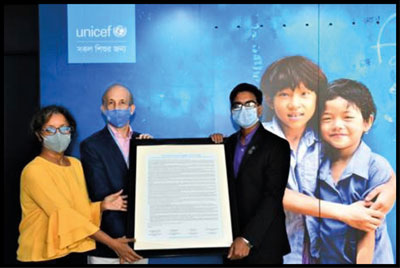Governments across South Asia need to urgently expand investments in basic health, education, and protection services for the millions of children and their families whose lives have been devastated by the COVID-19 pandemic and other disasters, says a new UNICEF report released on the agency’s 75th anniversary.
The report, “Reigniting Opportunities for Children in South Asia,” highlights the disproportionate impact that the pandemic has had on the most marginalized of the region’s 600 million children.
The report says that unless rollbacks in critical health, immunization, nutrition, protection and education services are reversed, the worst consequences of the COVID-19 pandemic will persist for decades.
The report notes that humanitarian disasters and climate-related hazards such as droughts, floods and air pollution have furthered exacerbated the situation for children.
Prior to the pandemic, South Asia was one of the fastest-growing regions in the world, with a large youth population poised to further accelerate growth and significant progress being made for children.
Child mortality rates more than halved in the past quarter century, while the number of children suffering from stunting fell by more than a third since 2000. Secondary school enrolment rose steadily, and the number of girls getting married before age 18 fell.
Over 90 per cent of the population has access to safe drinking water.
“The remarkable achievements our region has made in advancing child rights over recent decades are now at risk,” said George Laryea-Adjei, UNICEF Regional Director for South Asia.
“If we fail to act, the worst impacts of the COVID-19 pandemic will be felt for decades to come. But by acting now, we can reignite opportunities and ensure every child in South Asia not only survives but thrives.”
The report identifies immediate priorities, such as fully restoring basic health and immunization services and helping students catch up on the learning they have missed. But it also outlines the lessons learned and the opportunities that have been opened up by the pandemic which can now be leveraged into gains for all children.
They include public health systems that have been strengthened through infrastructure introduced to better respond to COVID-19 – such as improved cold chain and oxygen infrastructure.
Other opportunities include increased public conversations around mental health which are helping to spotlight needs and drive demand for more services, and increased recognition of the region’s deep digital divide and opportunities to bridge it.
While making urgent investments to reverse rollbacks in progress for children, the region also needs to be prepared for future waves of the pandemic, UNICEF said.
“Just 30 per cent of South Asia is fully vaccinated, leaving families dangerously unprotected as new variants continue to emerge,” George Laryea-Adjei said. “Governments around the world must ensure fair and equitable access to COVID-19 vaccines. The pandemic will not be over for anyone until it is over for everyone.”
The disproportionate impact of the pandemic on children was reiterated in a youth statement entitled “Our Future, Our Rights, Our Voices,” the outcome of extensive virtual consultations involving nearly 500 young people from the 8 South Asian countries.
“The COVID-19 pandemic has made our situation much worse. Our schools have been closed, often for months at a time. Many of us may never return to school,” said the statement, which was shared with UNICEF, the South Asia Association for Regional Cooperation (SAARC) and senior government officials. “With your action, we can transform the lives of young people in South Asia.”
The report outlines the key actions needed to reverse the rollbacks in progress for children, and begin building a better future for every child in South Asia, among them: 1. Expanding investment in child-sensitive social protection programmes, especially for the most vulnerable children and their families.
Resuming in-person learning in schools while addressing learning losses, bridging the region’s digital divide and improving the quality of education for every child.
Stronger integrated national health and nutrition systems that protect children from deadly but treatable diseases and reverse the region’s child nutrition crisis.
Protecting children from neglect and abuse and the promotion of the mental health of all children and young people.— Agencies










